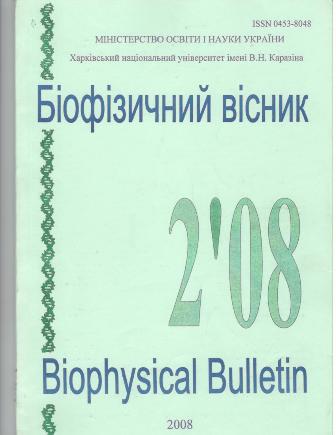Chlorpromazine effect on lysozyme-lipid interactions
Abstract
Despite considerable research efforts, the molecular mechanisms of anesthetic action still remain a matter of extensive debate. According to one viewpoint, anesthetics alter the properties of a lipid bilayer which, in turn, affects the functions of embedded membrane proteins. In contrast, protein-based theories of anesthetic action postulate that the drugs modulate the functions of membrane proteins through direct association. To develop a unique conception of anesthesia further in-depth investigations of drug-membrane interactions are strongly required. In the present work a well-known fluorescent probe pyrene has been employed to gain molecular insights into the interactions between amphipathic phenothiazine derivative chlorpromazine (CPZ) and model membranes composed of cationic globular protein lysozyme (Lz), and lipid vesicles prepared from zwitterionic lipid phosphatidylcholine (PC) and its mixtures with anionic lipid cardiolipin (CL) in the molar ratios 19:1, 9:1 and 4:1. To give an unambiguous interpretation of the drug effect on protein-lipid interactions, we first analyzed the changes in pyrene epimerization due to the formation of either CPZ-lipid or Lz-lipid complexes. Pyrene excimer-to-monomer intensity ratio (E/M), a parameter that reflects the alterations in membrane-free volume, was found to decrease upon Lz or CPZ binding to the lipid vesicles. Apparently, embedment of the protein and drug molecules into the hydrophobic region of lipid bilayer gives rise to the increase in lipid packing, decrease in the rate of trans-gauche isomerization of the lipid acyl chains, and, consequently, reduction of membrane-free volume. At the next step of the study, we analyzed the changes in the rate of pyrene epimerization upon Lz addition to drug-lipid mixtures. In CL-containing liposomes, the presence of CPZ does not modify the magnitude and sign of protein effect on membrane-free volume. This implies that CPZ is incapable of perturbing Lz structure and exerted no influence on the protein interactions with this kind of liposomes. In contrast, in PC vesicles E/M ratio appeared to increase upon lysozyme binding to CPZ-modified model membranes. This finding may be explained in terms of two possibilities: (i) CPZ induces the formation of the new Lz conformer whose interactions with lipid bilayers are accompanied by the increase in membrane-free volume; (ii) CPZ imparts the positive charge to the lipid bilayer thereby preventing Lz penetration into hydrophobic membrane region. Interfacially-located protein molecules are likely to generate structural defects coupled with the increased bilayer free volume. The results presented here clearly demonstrate that membrane composition can modulate the drug action on lipid-protein interactions. The recovered difference between the CPZ effect on Lz-lipid binding in PC and CL-containing bilayers provide support to the idea that the membrane environment can stabilize certain protein conformations differing in their responsiveness to drug action.
Downloads
References
2. B.W. Urban // Br. J. Anaesth. 2002. V. 89. P. 167-183.
3. R.G. Eckenhoff // Mol. Pharmac. 1998. V. 54. P. 610-615.
4. B. Mui et al. // Meth. Enzymol. 2003. V. 367. P. 3-14.
5. V.M. Ioffe, G.P. Gorbenko // Biophys. Chem. 2005. V. 114. P. 199-204.
6. A. Morton et al. // Biochemistry. 1995. V. 34. P. 8564-8575.
Authors who publish with this journal agree to the following terms:
- Authors retain copyright and grant the journal right of first publication with the work simultaneously licensed under a Creative Commons Attribution License that allows others to share the work with an acknowledgement of the work's authorship and initial publication in this journal.
- Authors are able to enter into separate, additional contractual arrangements for the non-exclusive distribution of the journal's published version of the work (e.g., post it to an institutional repository or publish it in a book), with an acknowledgement of its initial publication in this journal.
- Authors are permitted and encouraged to post their work online (e.g., in institutional repositories or on their website) prior to and during the submission process, as it can lead to productive exchanges, as well as earlier and greater citation of published work (See The Effect of Open Access).





